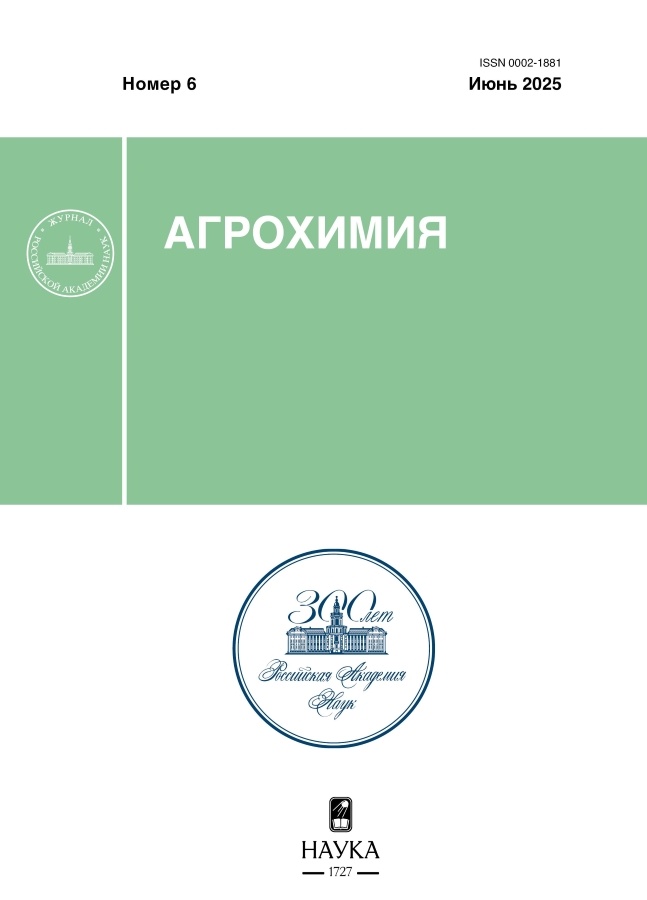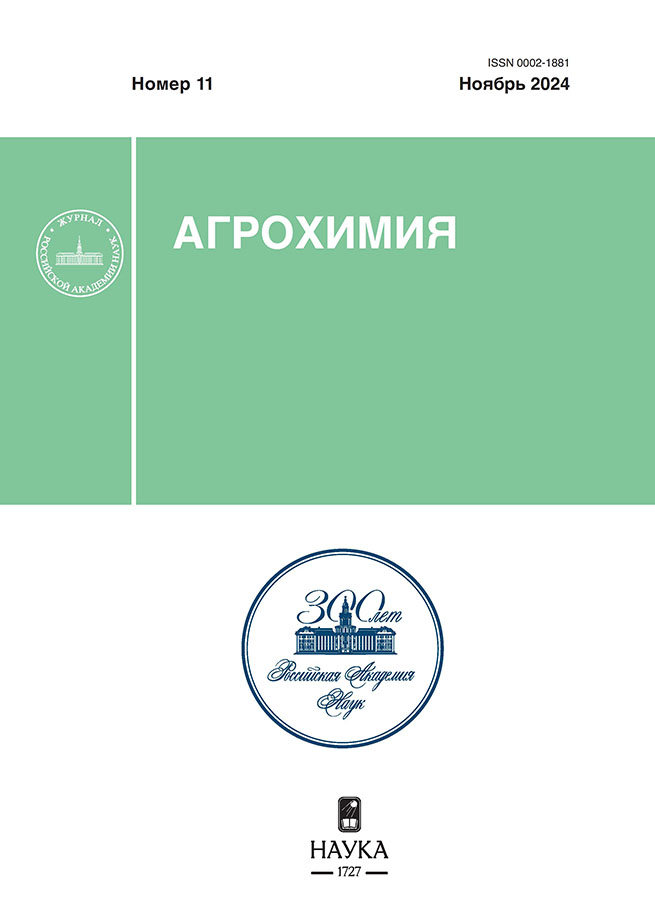Sensitivity of the pathogen of barley brown rust (Puccinia hordei G.H. Otth.) to fungicides – derivatives of triazoles and strobilurins
- Authors: Gvozdeva M.S.1, Danilova A.V.1, Kudinova O.A.1, Rudenko V.D.1, Volkova G.V.1
-
Affiliations:
- Federal Scientific Center for Biological Plant Protection
- Issue: No 11 (2024)
- Pages: 32-38
- Section: Experimental Articles. Pesticides
- URL: https://snv63.ru/0002-1881/article/view/647245
- DOI: https://doi.org/10.31857/S0002188124110051
- EDN: https://elibrary.ru/ahvzmb
- ID: 647245
Cite item
Abstract
The sensitivity of the North Caucasian population of the pathogen of barley brown rust (Puccinia hordei G.H. Otth.) to fungicides derived from triazoles and strobilurines (preparations Amistar Gold, SK; Amistar Extra, SK; Baliy, KME; Delaro, KS) was determined. The work was carried out under controlled conditions of the greenhouse complex of the Federal National Research and Development Fund on winter barley of the susceptible Vivat variety of the Agricultural Scientific Center “Donskoy”. Winter barley plants in the germination phase were infected with the North Caucasian population of the barley brown rust pathogen. Fungicide treatment was carried out at the first signs of the disease with application rates of 0 (control, without treatment), 50, 100, 150 and 200% (the recommended application rate is assumed to be 100%). It was found that when treating infected barley plants with the fungicide Baliy, KME with different application standards, the biological effectiveness varied from 87.3 to 100%, Delaro, KS – from 78.1 to 100%, Amistar Extra, SK – from 79.2 to 100%, Amistar Gold, SK – from 85.3 to 100%. The use of the recommended dose of treatment(100%) contributed to a decrease in the development of brown rust in all variants by more than 96.9%. When using increased rates of fungicides (150, 200%), the biological efficiency was 100%. The high sensitivity of the North Caucasian population of the pathogen P. hordei to the active substances of the studied fungicides has been proven. For all the studied drugs, the values of LC50 and LC95 were significantly lower in comparison with the recommended concentration in the working solution. The result obtained was due to the content of active substances in fungicides from different chemical classes with different mechanisms of action, which provided high efficiency in suppressing the development of barley brown rust and reduced the risk of resistance.
Full Text
About the authors
M. S. Gvozdeva
Federal Scientific Center for Biological Plant Protection
Author for correspondence.
Email: maria-v23@mail.ru
Russian Federation, p/o 39, Krasnodar 350039
A. V. Danilova
Federal Scientific Center for Biological Plant Protection
Email: maria-v23@mail.ru
Russian Federation, p/o 39, Krasnodar 350039
O. A. Kudinova
Federal Scientific Center for Biological Plant Protection
Email: maria-v23@mail.ru
Russian Federation, p/o 39, Krasnodar 350039
V. D. Rudenko
Federal Scientific Center for Biological Plant Protection
Email: maria-v23@mail.ru
Russian Federation, p/o 39, Krasnodar 350039
G. V. Volkova
Federal Scientific Center for Biological Plant Protection
Email: maria-v23@mail.ru
Russian Federation, p/o 39, Krasnodar 350039
References
- Гвоздева М.С., Волкова Г.В. Влияние фунгицида Колосаль на структуру популяции возбудителя бурой ржавчины пшеницы по признакам патогенности и чувствительности // Микол. и фитопатол. 2022. Т. 56. № 1. С. 52–63. doi: 10.31857/S0026364822010044
- Волкова Г.В. Генерация резистентности у желтой ржавчины пшеницы (возбудитель Puccinia striiformis West.) к фунгицидам // Вестн. защиты раст. 2001. № 2. С. 29–34.
- Damicone J.P. Fungicide resistance management. Oklahoma cooperative extension. URL: https://shareok.org/bitstream/handle/11244/319916/oksaepp_ 7663_2014–02.pdf?sequence=1
- Дьяков Ю.Т. Популяционная биология фитопатогенных грибов. М., 1998. 377 с.
- Данилова А.В., Волкова Г.В. Карликовая ржавчина – прогрессирующее заболевание ячменя // Защита и карантин раст. 2015. № 7. С. 46–48.
- Danilova A.V., Volkova G.V. Short communication: Virulence of barley leaf rust in the South of Russia in 2017–2019 // Span. J. Agricult. Res. 2022. V. 20. № 1.
- Говоров Д.Н., Живых А.В., Шабельникова Е.С., Никулин А.Н., Умников В.И., Долгов А.И., Волков И.А., Машенцев И.В., Ступаков А.И., Чернявский В.С. Обзор фитосанитарного состояния посевов сельскохозяйственных культур в Российской Федерации в 2020 году и прогноз развития вредных объектов в 2021 году / Под ред. Говорова Д.Н., Живых А.В. М.: ФГБУ РСЦ, 2021. 912 с.
- Волкова Г.В., Данилова А.В., Кудинова О.А. Вирулентность популяции возбудителя карликовой ржавчины ячменя на Северном Кавказе в 2014–2017 гг. // Сел.-хоз. биол. 2019. № 3. С. 589–596.
- Государственный каталог пестицидов и агрохимикатов, разрешенных к применению на территории Российской Федерации / Министерство сельского хозяйства Российской Федерации (Минсельхоз России) Издание официальное МОСКВА 2024.URL: https://www.agroxxi.ru/goshandbook (дата обращения: 17.01.2024).
- Щербакова Л.А. Развитие резистентности к фунгицидам у фитопатогенных грибов и их хемосенсибилизация как способ повышения защитной эффективности триазолов и стробилуринов // Сел.-хоз. биол. 2019. № 5. С. 875–891.
- Fungicide resistance management in cereals FRAG-UK, Kenilworth, 2019.
- Обзор фитосанитарного состояния посевов сельскохозяйственных культур в Российской Федерации в 2023 году и прогноз развития вредных объектов в 2024 году / Сост. Д.Н. Говоров, А.В. Живых, А.А. Шабельникова, А.Н. Никулин, В.И. Умников, В.С. Чернявский, Д.А. Варенова, К.О. Шилова, Е.Г. Матюхина, А.А. Кудрявцев / Под ред. Говорова Д.Н., Живых А.В. М.: ФГБУ РСЦ, 2023. 1281 с.
- Михайликова В.В., Стребкова Н.С., Пустовалова Е.А. Действующие вещества – основа химической защиты растений // Агрохимия. 2020. № 5. С. 44–46. doi: 10.31857/S0002188120050105
- Анпилогова Л.К., Волкова Г.В. Методы создания искусственных инфекционных фонов и оценки сортообразцов пшеницы на устойчивость к вредоносным болезням (фузариозу колоса, ржавчинам, мучнистой росе): Рекоменд. Краснодар, 2000. 28 с.
- Методические указания по регистрационным испытаниям фунгицидов в сельском хозяйстве / Под ред. В.И. Долженко. СПб.: ВИЗР, 2009. 377 с.
- Shafiei M., Peyton L., Hashemzadeh M., Foroumadi A. History of the development of antifungal azoles: A review on structures, SAR, and mechanism of action // Bioorganic Chem. 2020. V. 104. Р. 104240.
- Тютерев С.Л. Механизмы действия фунгицидов на фитопатогенные грибы. СПб.: Нива, 2010. 170 с.
- Stenzel K., Vors J.‐P. Sterol biosynthesis inhibitors // Modern Crop Protect. Comp. 2019. V. 2. Р. 797–844.
- Yang L.N., He M.H., Ouyang H.B., Zhu W., Pan Z.C., Sui Q.J., Shang L.P., Zhan J. Cross-resistance of the pathogenic fungus Alternaria alternata to fungicides with different modes of action // BMC Microbiol. 2019. V. 19. Р. 1–10.
- Zhai W., Zhang L., Cui J., Wei Y., Wang P., Liu D., Zhou Z. The biological activities of prothioconazole enantiomers and their toxicity assessment on aquatic organisms // Chirality. 2019. V. 31(6). Р. 468–475.
- Abebe W. Wheat leaf rust disease management: A Review // J. Plant Pathol. Microbiol. 2021. V. 12. P. 1–8.
- Гвоздева М.С., Волкова Г.В., Изварина А.Г., Жуйко И.А. Чувствительность возбудителя бурой ржавчины пшеницы к фунгицидам триазоловой группы // Достиж. науки и техн. АПК. 2022. Т. 36. № 12. С. 13–19. doi: 10.53859/02352451_2022_36_12_30
- Гвоздева М.С., Волкова Г.В. Изучение влияния комбинированного фунгицида Абакус Ультра на структуру популяции возбудителя бурой ржавчины пшеницы // Юг России: экол., развитие. 2022. Т. 17. № 4. C. 79–87. doi: 10.18470/1992-1098-2022-4-79-87
Supplementary files














